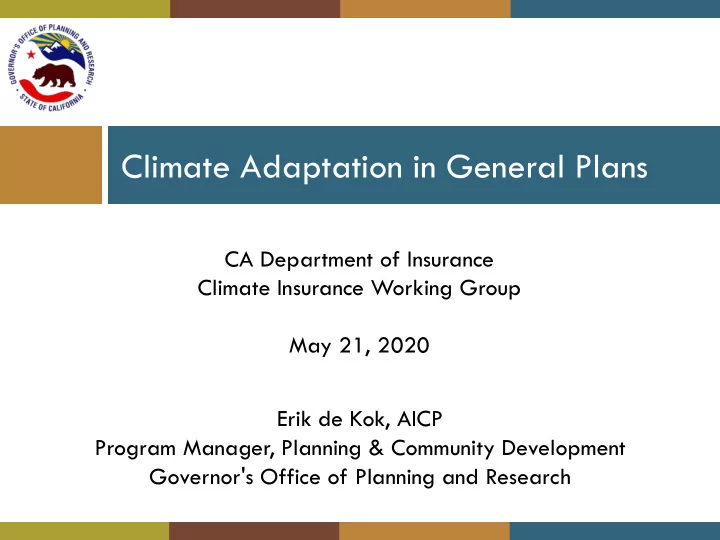

Climate Adaptation in General Plans CA Department of Insurance Climate Insurance Working Group May 21, 2020 Erik de Kok, AICP Program Manager, Planning & Community Development Governor's Office of Planning and Research
General Plan Elements 2 Required Elements Topical Considerations Land Use Climate Change Circulation Public Health Housing Equity Conservation Resilience Open Space Economic Noise Development Safety Air Quality* Environmental Justice*
Safety Element Overview 3 Natural hazards: wildfire, flooding, earthquake, others Must identify “ unreasonable risks and policies for the protection of the community from such risks ” (Gov’t Code 65302(g)(1)) Additional Requirements and Relationship to Other Plans: Climate Adaptation (SB 379, SB 1035) Local Hazard Mitigation Plans (LHMPs) Community Wildfire Protection Plans, Flood Protection Plans, etc. Linkages with mandatory elements or other topics Land Use, Circulation, Conservation, Open Space, Environmental Justice, others
Safety Element: Climate Adaptation SB 379 (2015) – safety element must address climate vulnerability and adaptation Timing: upon next update to the local hazard mitigation plan on or after January 1, 2017; or, by January 1, 2022 if no local hazard mitigation plan. OK to incorporate other plans by reference SB 1035 (2018) - added regular review and update to flood, fire hazards, and climate adaptation portions of the safety element Timing: housing element update every 8 years
Safety Element - Adaptation What does SB 379 require? A vulnerability assessment that identifies the risks that A. climate change poses to the local jurisdiction and the geographic areas at risk from climate change impacts, including (but not limited to) an assessment of how climate change may affect the risks identified in the safety element Adaptation and resilience goals, policies, and objectives B. based on the findings of the vulnerability assessment Feasible implementation measures designed to carry out C. the goals, policies, and objectives
Adaptation Planning Process 6 Source: California Adaptation Planning Guide 2.0
Vulnerability Assessment How will climate change affect my jurisdiction? Historical data on natural events and hazards Vulnerability maps and areas that have repetitive loss Climate exposure data (e.g., Cal-Adapt) What assets, resources and populations are sensitive to various climate change impacts? Existing and planned development in at-risk areas? Current status of climate change preparedness and adaptive capacity?
Adaptation Goals, Policies, Implementation How will my jurisdiction reduce climate-related risks to people, assets, and natural resources with new land use decisions? How will climate adaptation and resilience measures be incorporated into proposed development? Where are our existing at-risk and resilient critical facilities? How can existing buildings and development be made resilient and protect health and safety? How will our jurisdiction partner or collaborate with other local, regional, state, and federal agencies? What natural infrastructure options should be prioritized?
Integrating Other Plans and Funding OK to use existing plans for SB 379 / SB 1035 compliance Examples: climate adaptation plan, climate action plan, LHMP , or other plans may be used. Incorporation existing plan by reference, or direct incorporation of content, or both are all acceptable. Other plans must be consistent with statutory safety element requirements. AB 2140: LHMP + Safety Element LHMPs may be incorporated by reference into Safety Element Eligibility for disaster mitigation funding: CA Disaster Assistance Act will cover local share of the 25% non-federal portion of FEMA-funded projects Opportunity for alignment of SB 379 adaptation updates with LHMP and other Safety Element updates
Adaptation Planning Resources General Plan Guidelines (2017) Chapter 4: Required Elements Safety Element Environmental Justice Chapter 3: Community Engagement and Outreach Chapter 5: Equitable and Resilient Communities Chapter 6: Healthy Communities
Adaptation Planning Resources Adaptation Planning Guide Governor’s Office of Emergency Services (OES), OPR, and others Version 2.0 to be finalized soon Cal-Adapt (cal-adapt.org) Online tool for viewing and obtaining downscaled climate change data and related datasets UC Berkeley Geospatial Innovation Facility, funded by CA Energy Commission
Adaptation Planning Resources California’s Fourth Climate Change Assessment www.climateassessment.ca.gov/ Adaptation Clearinghouse resilientca.org Managed by OPR under the Integrated Climate Adaptation and Resilience Program (ICARP)
Thank You 13 Erik de Kok, AICP Governor’s Office of Planning & Research erik.dekok@opr.ca.gov
Recommend
More recommend